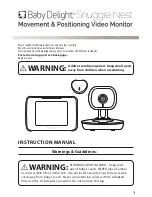
Connect Braille
Operation of Screen Readers
Page 32
Control Key/Braille Dot
Function
[2 3]
Beginning of line
[5 6]
End of line
[1 2 3]
Top of file
[4 5 6]
End of file
[3 6 7]
Speech interruption on/off
[3 6 7 8]
Output task bar
[TLC]
Tab
[TRC]
Shift + Tab
[TLC + TRC]
Enter
[SPC + 1 2 7]
Toggle Braille input on/off
[SPCL + 1 2 3 7 ]
If there is any text to the left of the Braille display section,
it moves to the left, if not, it moves one line up.
[SPCR + 4 5 6 8]
If there is any text to the right of the Braille display section,
it moves to the right, if not, it moves one line down.
[SPCL + SPCR + 1 2 3 7]
Move the Braille display section one line up.
[SPCL + SPCR + 4 5 6 8]
Move the Braille display section one line down.
By entering letters in Braille, you can in addition input the so-called mnemonic commands
that are listed below:
j
[2 4 5]
Activate the JAWS settings menu
% [1 2 3 4 5 6]
Activate the screen reader settings menu (JAWS)
d
[1 4 5]
Desktop minimizes all applications
h
[1 2 5]
Activate JAWS Help (paste + F1)
$
[4 6]
Tab
k
[1 3]
Shift Tab
g
[1 2 4 5]
Grade 2 on/off
m [1 3 4]
Alternative for activating the menu bar
s
[2 3 4]
Start menu
+
[2 3 5]
Toggle 6/8 dot Braille
=
[2 3 5 6]
System Tray
z
[1 3 5 6]
Announce time
|
[3 4]
Status cells on/off
c
[1 4]
Ctrl+Tab
C [1 4 7]
Shift Ctrl+Tab
e
[1 5]
ESC
?
[2 6]
Enter
b
[1 2]
Braille cursor tracking on/off
f
[1 2 4]
Active cursor tracking on/off
v
[1 2 3 6]
Set level of Braille contractions
The cursor routing keys (CR) are used to directly place the cursor at that text position. In
addition, the following functions can be initiated by activating cursor routing keys in
combination with certain control keys.
[CR + 1] or [CR + 4]
Mark a text block (beginning and end of block)
[CR + 6]
Describe object at the CR position















































